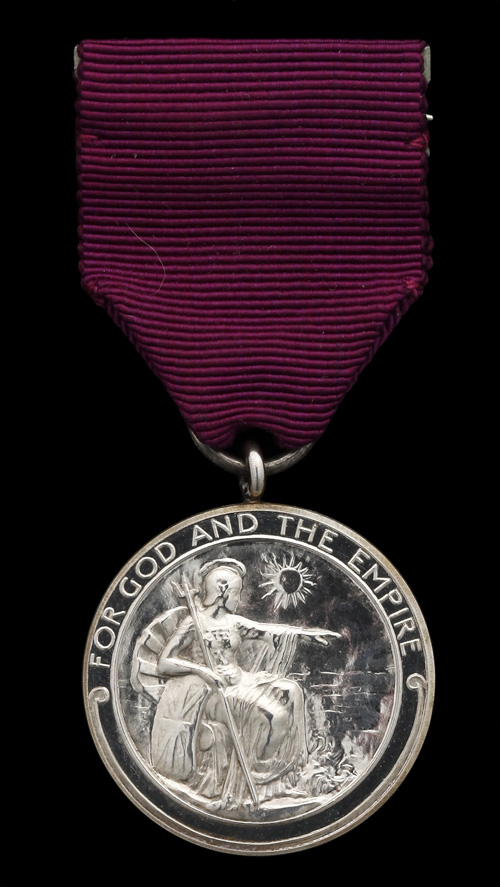
Auction: 1005 - Orders, Decorations, Campaign Medals & Militaria
Lot: 38
The Highly Emotive Medal of the Order of the British Empire to Poplar School-Mistress Miss E.W. Watkins, For Heroism in Rescuing Injured Children From Her School After It Had Received a Direct Hit During the First Major Enemy Daylight Bombing Raid on London, 13.6.1917 Medal of the Order of the British Empire, Civil Division, unnamed as issued, mint state, in John Pinches, London, case of issue, with the following related letters &c.: - Letter to the recipient from Alfred Yeo, M.P., Member for Poplar, dated 14.6.1917 - Letter to the recipient from Reginald Blair, M.P., Member for Bow and Bromley, congratulating her on the award of the Medal, dated 13.6.1918 - Two Letters to the recipient regarding the Presentation of the Medal, dated 6.11.1918 and 28.11.1918 - Letter to the recipient from the Women´s Work Sub-Committee, Imperial War Museum, requesting her photograph for a collection, dated 20.1.1919 - A comprehensive file of research relating to the incident, including an original newspaper page from the Daily Sketch, dated 14.6.1917, reporting on the raid. Estimate £ 350-450 Medal of the Order of the British Empire London Gazette 11.6.1918 Watkins, Emma Wenceslia, Assistant Mistress (Infants´ Department). ´Displayed very conspicuous courage and presence of mind on the occasion of an air raid, when a bomb burst in the classroom in which she was teaching.´ The Poplar Air Raid The first organised mass enemy bombing raid on London, carried out by a force of 20 German Gotha Bombers, took place on the 13th June, 1917. Leaving Ghent at 10:00am, the Gothas arrived over the East End of London at approximately 11:20am. After bombing Liverpool Street Station, the raiders split into two groups, one to attack London Bridge Station, the other to bomb the railway sidings at Dalston. Following this attack, the northern group headed south. As they neared the Thames, they passed over Poplar. At 11:40am a 110-pound bomb struck the Upper North Street School, Poplar, attended at the time by 600 pupils. Breaking in two as it hit the roof, the bomb did not explode immediately: instead, one piece pierced three floors to reach an infants´ class in the basement, where 64 children were being taught in one large partitioned room. Two of the teachers, Miss Watkins and Miss Middleton, saw the ceiling come crashing down along with one child from the floor above. Then, with a sudden sharp bang, the bomb fragment exploded. ´We had not the slightest warning until we heard this awful noise. I was collecting things on one side of the room, and we were going to get on with the work. Then there was this great noise and row of falling. There was a sudden darkness and a strong smell of fumes. We could see nothing, and there was some stuff in the room that made the children gasp. It filled my throat, and I thought that I was being buried alive and suffocated at the same time. The children were just the same. The school seemed to be falling over. Through a door on one side I saw a gleam of light right down the corridor. I called out to the children. There was a lot of broken glass and water about, the bomb having burst a pipe. Of the children that were injured in my class I carried four out, and I think that one was dead.´ (Miss Watkins´ account at the Coroner´s inquest, reported in the Star, 15.6.1917, refers). 18 children at the School were killed outright, and thirty others were injured. Only three of the dead were over 5 years old. London was appalled by this ´massacre of innocents´. Flowers and messages of condolence poured in, including a personal message from HM the King, and Queen Alexandra visited the School. A Public Funeral was held a week later for 15 of the dead children, conducted by the Lord Bishop of London, with thousands lining the route of the funeral pageant. An enormous crowd also gathered at the gates of East Ham Cemetery, where the children were buried in a common grave, over which a memorial was later erected. At the time of the raid Miss Watkins was living at Crouch End, London N8. She was presented with her Medal by the Lord Lieutenant of Middlesex on the 5th December, 1918, at the Guildhall.
Sold for
£1,150




